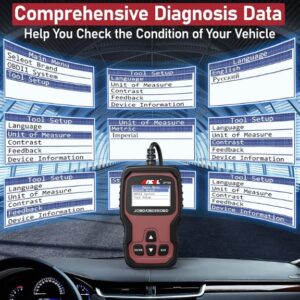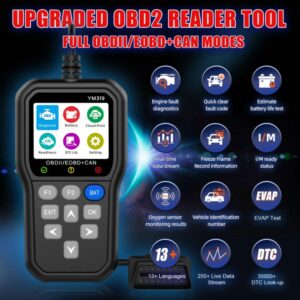Using OBD II Tools for 2JZ-GTE Engine Diagnostics
The automotive world has witnessed remarkable advancements over the years, and among the most significant is the development of On-Board Diagnostics (OBD) systems. These systems have revolutionized how car enthusiasts and professionals alike approach vehicle maintenance and troubleshooting. For those passionate about performance cars, especially those with the iconic 2JZ-GTE engine, understanding and utilizing OBD II tools is essential.
What are OBD II Tools?
OBD II, or On-Board Diagnostics II, is a standardized system found in most vehicles manufactured after 1996. This system provides real-time data and diagnostic trouble codes (DTCs) that help identify and troubleshoot issues within a vehicle’s engine and other subsystems. By connecting an OBD II tool to the vehicle’s Data Link Connector (DLC), users can access valuable information regarding the engine’s performance, emissions, and other critical parameters.
Why Focus on the 2JZ-GTE Engine?
The 2JZ-GTE engine, a 3.0-liter inline-six turbocharged powerhouse, is renowned among car enthusiasts for its robustness and high-performance potential. Found in the Toyota Supra MKIV, this engine has become a legend in the tuning and racing communities. Given its complexity and performance capabilities, maintaining the 2JZ-GTE engine requires precise diagnostics and regular monitoring, making OBD II tools indispensable.
Importance of OBD II Tools for 2JZ-GTE Engine Diagnostics
Using OBD II tools for 2JZ-GTE engine diagnostics offers numerous benefits. These tools allow for efficient troubleshooting by pinpointing specific issues, thus saving time and reducing guesswork. Additionally, they enable performance tuning by providing real-time data on various engine parameters. Regular use of OBD II tools also contributes to preventive maintenance, ensuring that potential problems are identified and addressed before they escalate, thereby prolonging the engine’s lifespan.
In this comprehensive guide, we will delve into the various aspects of using OBD II tools for 2JZ-GTE engine diagnostics. We will explore the different types of OBD II tools available, the benefits they offer, common diagnostic procedures, and best practices for their effective use. Whether you’re a seasoned car enthusiast or a professional mechanic, this guide aims to equip you with the knowledge needed to keep your 2JZ-GTE engine in peak condition using OBD II tools.
Overview of OBD II Tools
Understanding the basics of OBD II tools is the first step toward effective engine diagnostics. OBD II tools are designed to interface with a vehicle’s OBD system, providing valuable data and diagnostics capabilities.
Types of OBD II Tools
- Basic Code Readers: These are simple devices that read and clear diagnostic trouble codes (DTCs). They are user-friendly and perfect for car enthusiasts who need to perform basic diagnostics.
- Scan Tools: These are more advanced than basic code readers and offer real-time data, freeze frame data, and comprehensive diagnostics capabilities. They often include features such as live data streaming, graphing capabilities, and manufacturer-specific codes.
- PC-Based OBD II Interfaces: These tools connect to a laptop or PC, allowing users to use specialized software for in-depth diagnostics and data analysis. They are ideal for advanced diagnostics and tuning.
- Bluetooth/Wi-Fi Adapters: These adapters connect to a smartphone or tablet via Bluetooth or Wi-Fi. They offer portability and convenience, with many apps providing extensive diagnostic and monitoring features.
How OBD II Tools Work
OBD II tools connect to the vehicle’s Data Link Connector (DLC), usually located under the dashboard. Once connected, the tool communicates with the vehicle’s Engine Control Unit (ECU) to retrieve diagnostic trouble codes, sensor data, and other relevant information. This data can then be analyzed to diagnose issues, monitor performance, and perform various maintenance tasks.
By using OBD II tools, car enthusiasts can gain a deeper understanding of their vehicle’s health and performance, enabling them to make informed decisions about maintenance and tuning.
Benefits of Using OBD II Tools for 2JZ-GTE Engine
The 2JZ-GTE engine is a marvel of engineering, and maintaining its peak performance requires precise and effective diagnostics. OBD II tools offer several key benefits for enthusiasts and professionals working with this engine.
Efficient Diagnostics and Troubleshooting
OBD II tools provide access to diagnostic trouble codes (DTCs) that help identify specific issues within the engine and other subsystems. For the 2JZ-GTE engine, this means pinpointing problems quickly and accurately, whether it’s a sensor malfunction, fuel system issue, or any other fault. This efficiency saves time and reduces the guesswork involved in troubleshooting.
Enhanced Performance Tuning
For car enthusiasts looking to extract maximum performance from their 2JZ-GTE engine, OBD II tools are indispensable. These tools allow for real-time monitoring of various engine parameters, such as air-fuel ratio, ignition timing, and boost pressure. By analyzing this data, enthusiasts can make precise adjustments to optimize performance. Whether it’s for track days or daily driving, using OBD II tools ensures that the engine runs at its best.
Preventive Maintenance and Longevity
Regular use of OBD II tools enables preventive maintenance by identifying potential issues before they become major problems. For example, early detection of a failing sensor or a misfire can prevent more serious engine damage down the line. By keeping the 2JZ-GTE engine in optimal condition, enthusiasts can ensure its longevity and reliability.
In summary, the benefits of using OBD II tools for the 2JZ-GTE engine are manifold. They offer efficient diagnostics, enhance performance tuning, and contribute to preventive maintenance, ensuring that this legendary engine remains in peak condition.
Common Diagnostic Procedures for 2JZ-GTE Engine Using OBD II Tools
Effective diagnostics are crucial for maintaining the performance and health of the 2JZ-GTE engine. Here are some common diagnostic procedures that can be performed using OBD II tools.
Connecting the OBD II Tool to the 2JZ-GTE Engine
- Locate the DLC: The Data Link Connector (DLC) is typically located under the dashboard near the steering column.
- Connect the Tool: Plug the OBD II tool into the DLC. Ensure a secure connection to establish communication with the ECU.
- Turn on the Ignition: Switch the vehicle’s ignition to the ON position without starting the engine. This powers the OBD system and allows the tool to communicate with the ECU.
Reading and Interpreting Diagnostic Trouble Codes (DTCs)
- Access DTCs: Use the OBD II tool to access stored diagnostic trouble codes. These codes indicate specific issues within the engine and other systems.
- Interpret Codes: Refer to the OBD II tool’s manual or online resources to interpret the DTCs. Each code corresponds to a particular issue, such as a sensor failure or misfire.
- Clear Codes: After addressing the issues indicated by the DTCs, clear the codes using the OBD II tool. This resets the system and allows for fresh diagnostics.
Performing Real-Time Monitoring and Data Logging
- Select Parameters: Choose the engine parameters you want to monitor in real-time. Common parameters include air-fuel ratio, boost pressure, engine speed, and coolant temperature.
- Monitor Data: Observe the data on the OBD II tool’s display. Look for any anomalies or deviations from normal values that might indicate underlying issues.
- Log Data: Use the data logging feature to record engine parameters over a period of time. This is particularly useful for performance tuning and identifying intermittent problems.
By following these procedures, car enthusiasts can effectively diagnose and maintain their 2JZ-GTE engine, ensuring optimal performance and reliability.
Best Practices for Using OBD II Tools
To maximize the benefits of OBD II tools, it’s essential to follow best practices. Here are some tips to ensure effective use of these diagnostic tools for the 2JZ-GTE engine.
Regular Maintenance Checks
- Scheduled Diagnostics: Perform regular diagnostic checks as part of your vehicle’s maintenance routine. This helps in early detection of potential issues.
- Periodic Monitoring: Use OBD II tools to periodically monitor key engine parameters, even if no issues are apparent. This proactive approach can prevent problems from developing.
Keeping Software Updated
- Update Firmware: Ensure that the OBD II tool’s firmware is up to date. Manufacturers often release updates to improve functionality and compatibility with newer vehicle models.
- Use the Latest Software: If using PC-based or smartphone apps, always use the latest version of the software. This ensures access to the most current features and diagnostic capabilities.
Understanding and Interpreting Data Correctly
- Refer to Manuals: Always refer to the OBD II tool’s manual and relevant resources to correctly interpret diagnostic trouble codes and real-time data.
- Consult Experts: When in doubt, consult automotive experts or online forums for advice on interpreting complex data and resolving issues.
Proper Tool Handling and Storage
- Handle with Care: Treat the OBD II tool with care. Avoid dropping or exposing it to extreme temperatures and moisture.
- Store Properly: Store the tool in a safe, dry place when not in use. Proper storage extends the tool’s lifespan and ensures reliable performance.
By adhering to these best practices, car enthusiasts can effectively use OBD II tools to maintain and enhance the performance of their 2JZ-GTE engine.
Conclusion
In conclusion, using OBD II tools for 2JZ-GTE engine diagnostics is not just a matter of convenience but a necessity for car enthusiasts and professionals who want to ensure optimal performance and longevity of their engines. These tools offer a wealth of information that can be harnessed to identify issues quickly, perform precise tuning, and undertake preventive maintenance.
The 2JZ-GTE engine, with its legendary performance capabilities, demands meticulous care and attention. By integrating OBD II tools into your regular maintenance routine, you can stay ahead of potential problems, fine-tune your engine for peak performance, and ultimately enjoy a more reliable and exhilarating driving experience.
If you own a vehicle equipped with a 2JZ-GTE engine, investing in a quality OBD II tool is a step you won’t regret. Start by exploring the different types of OBD II tools available and choose one that fits your needs and expertise level. Regularly perform diagnostics and keep an eye on your engine’s health. By doing so, you’ll not only protect your investment but also enhance your driving pleasure.
Take control of your 2JZ-GTE engine’s performance today by integrating OBD II tools into your maintenance routine. Your engine deserves the best, and so do you.
Frequently Asked Questions (FAQ)
What are the essential features of an OBD II tool for the 2JZ-GTE engine?
When choosing an OBD II tool for the 2JZ-GTE engine, look for features such as real-time data monitoring, the ability to read and clear diagnostic trouble codes (DTCs), data logging capabilities, and compatibility with various diagnostic protocols. Tools that offer comprehensive diagnostic functions and user-friendly interfaces are highly recommended.
How often should I use an OBD II tool for diagnostics?
It is advisable to use an OBD II tool for diagnostics at least once a month or whenever you notice any unusual behavior in your engine. Regular checks help in early detection of potential issues and ensure that your 2JZ-GTE engine remains in optimal condition.
Can I perform engine tuning with an OBD II tool?
Yes, many advanced OBD II tools allow for engine tuning by providing real-time data on various engine parameters such as air-fuel ratio, ignition timing, and boost pressure. By analyzing this data, you can make precise adjustments to enhance your engine’s performance. However, for more extensive tuning, specialized tuning software and expertise may be required.
What should I do if my OBD II tool cannot connect to the 2JZ-GTE engine?
If your OBD II tool cannot connect to the 2JZ-GTE engine, first check the connection to ensure the tool is properly plugged into the Data Link Connector (DLC). Ensure that the ignition is in the ON position. If the tool still fails to connect, consult the tool’s manual for troubleshooting steps or seek assistance from a professional.
Are there any specific OBD II tools recommended for the 2JZ-GTE engine?
While many OBD II tools are compatible with the 2JZ-GTE engine, some popular choices among car enthusiasts include the ScanGauge II, BlueDriver Bluetooth Professional OBDII Scan Tool, and the Techstream software used by Toyota dealerships. These tools offer extensive diagnostic capabilities and are well-suited for the 2JZ-GTE engine.

